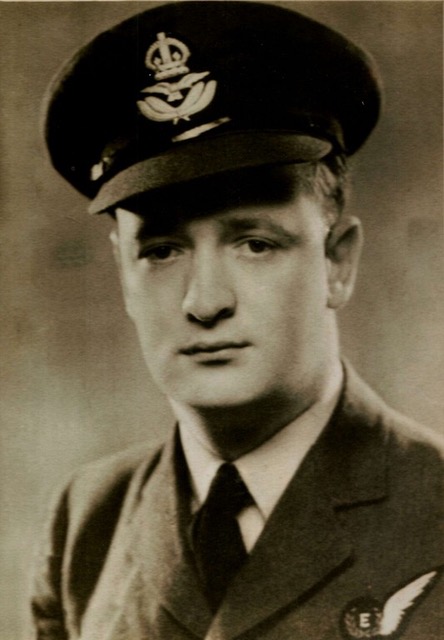
21st September 1921 to 1st January 1949
Early Years
John Hewson Jenkins Thomas was born on Wednesday 21st September 1921 at the Braich Y Cymmer Hotel, Pontyrhyl near Bridgend in South Wales. He was the first of six children. Pontyrhyl was a Welsh speaking area and John would grow up bilingual. He would do well at school and complete his secondary education but not attend grammar school. As a boy he was always interested in aircraft and was keen to join the RAF and on Tuesday 7th September 1937 aged just 15 years, 11 months, 17 days John enlisted at RAF Halton, Aylesbury, Buckinghamshire.
1937-1942 RAF Fitter 2E
John would be stationed at RAF Halton in 1937, RAF Cosford in August 1938 and mustered as an Under Training Fitter 2E. He arrived at the School of Air Navigation at RAF St Athan in December 1939 mustered as a Fitter 2E. This would have been handy for him as his parents home which was now in Bridgend was only a few miles away. John would stay at RAF St Athan until October 1940 when he was posted to No. 1 Air Navigation School which was located in Canada. Interestingly John’s record states he was posted to there the same date it was relocated to Canada, this would indicate that John was among the first to be posted to that school in Canada.
In May 1942 John was back in the UK and posted to 17 P A.F.U. at RAF Watton 9 miles southwest of East Dereham, Norfolk where he would remain here until late September 1942.
1942 – Remustering as a Flight Engineer
He was then posted to No 4 School of Technical Training at RAF St Athan and mustered Fitter 2E Under Training Flight Engineer. His record shows that between the 07/10 to 28/10/1942 he under took his Flight Engineer Technical Course and passed with 63.4% B rate and was promoted to Sergeant and mustered as a Flight Engineer.
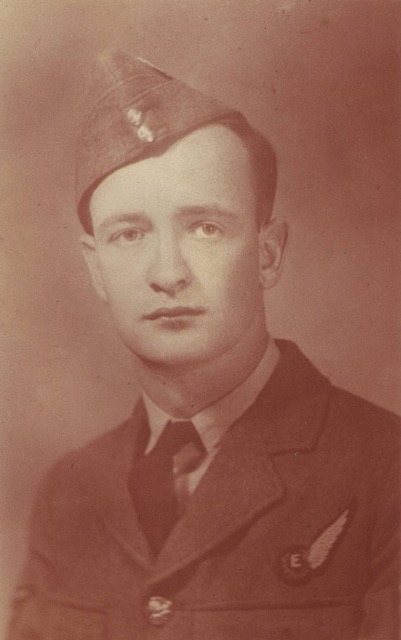
On 2nd November 1942 John was then posted to 10 Conversion Flight part of RAF 10 Squadron based at RAF Melbourne about 5 miles to the south west of Pocklington, Yorkshire. John was not here very long only a month, but it may have been less with transport to and from here. 10 Con Flt would became part of 1658 H.C.U. (Heavy Conversion Unit) based at RAF Riccall about 15 miles from RAF Melbourne. At the H.C.U. each crew picked up a flight engineer and here John would be assigned or picked by a crew. He joined the crew of Pilot Officer (though soon Flying Officer) Robert Hilary ‘Vivian’ Thomas a fellow Welshman who was from Swansea, he was known as Tommy in the RAF but in civilian life was known as Vivian. It is possible that he joined Vivian’s crew because they were both Welsh and no doubt wanted to keep the ‘Taffs’ together.
1658 H.C.U. used the Handley Page Halifax four engined heavy bomber, an aircraft John would stay with all through his career. While at RAF Riccall John would meet his future wife whom he would marry some years later. The story within the family is that they met when she tripped over a tent rope and John caught her. John and his crew would complete the conversion to the Halifax and it is believed that in January 1943 the whole crew moved to RAF Lyneham. It is known that Flying Officer Vivian Thomas was posted to here in January and he states in his log that he flew with his crew but flew Wellingtons until the crew received their posting to a Halifax squadron in late March 1943.
1943 – No 462 Sqn (RAAF) Libya
On 28th March having had to replace their wireless operator who was quite ill John and the crew set off for the Middle East in a Vickers Wellington GR Mk VIII. Their route would take them via RAF Portreath in Cornwall, Gibraltar, RAF Castel Benito, Libya, Marble Arch, Libya, RAF El Adem, Libya, RAF Cairo West, Egypt and finally delivering their Wellington to RAF Fayed, Egypt on 7th April.
John and the crew had been posted to RAAF 462 Squadron which at the time was based at Gardabia Main, Libya but would soon move to Hosc Raui a tented landing strip just south of Benghazi, Libya. Although an Australian squadron most of its personnel were RAF, though as 1943 progressed more Australians were to be posted in and RAF out. During the next 10 weeks or so John and the crew would carry out air tests, circuits and landings and be evaluated. On 19th July 1943 John would carry out his first of 24 operations, all of which were with Flying Officer Vivian Thomas as pilot. They had their fair share of hiccups, engine failures, aborted operations just like all crews but in the main they were a successful crew.
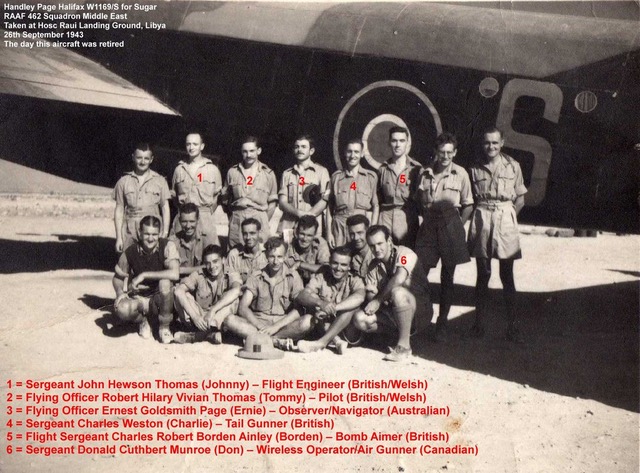
The morning of the 28th September 1943 was to change John’s life for ever.
They were detailed as a flare dropper for an operation to attack Larissa Aerodrome, Greece with 105 flares. They had to abandon the task an hour from the target because of a problem with the starboard inner engine. They made for home but they were still carrying 105 flares. At 01.10 am Halifax BB321/S met her fate at the Hosc Raui landing field.
Upon reaching the Hosc Raui base they made a left hand circuit of the landing ground and began to make their landing. Flying Officer Vivian Thomas recorded in his pilot’s log book and it is known from the accident report card for BB321 that the undercarriage collapsed on landing. The reasons for making such a heavy landing are not known, perhaps there were hydraulic issues or the undercarriage was not locked securely. Perhaps Vivian miss judged their height and landed sooner than expected. The landing ground was in total darkness and that close to the ground the aircraft’s altimeter would not have been accurate. It may have been the extra weight on board as still carrying their flares that meant the aircraft did not perform as expected. The reason will never be known now and was probably a result of multiple factors. It is known however from the accident report card that the accident was attributed to pilot’s error of judgement.
BB321 broke up when she hit the ground as was common to the Halifax and the saviour of many a crewman. Sergeant Don Monroe their wireless operator years later recalled “We landed with the thing and it crashed and the plane split. We all had to get out.” Don and other members of the crew scrambled out of the stricken Halifax, he would comment later “It was pitch black where we landed on our little strip. You thought you had a long way to go when you’re off the wing, but it was on the ground, so you hurt yourself more jumping off this, little ways than you did in the crash”. Don Munroe would rescue Vivian Thomas and the rear gunner Charlie Weston from the stricken Halifax before all the crew ran away from it seconds before it exploded.
The only official injury during the crash was the rear gunner sustained minor cuts but it is known that Vivian was knocked out and John too sustained a head injury. It was this injury that soon would begin to cause John issues over the coming weeks. Around this period John would begin to suffer black outs on take-off and landings and begin to miss flights. There are instances where the official records show him as flight engineer but the pilots log names another engineer aboard. John would make his last operation with the squadron on 10th November but would still carry out test flights with Flying Officer Vivian Thomas until 6th December. John’s service record states that he was posted to the UK on the 22nd December 1943.
1943 Return to St Athan
John would make a short return to RAF Cosford before a lengthy return to RAF St Athan until October 1944 where it is believed he was now an instructor. Alas his medical records are not available but it is known that John was unwell after leaving the Middle East. It is believed he was posted near his home and was undergoing tests also during this time. He did however become fit again to resume active duty.
1944 No 644 Squadron
On 10th November 1944 he was posted to No 644 Squadron at RAF Tarrant Rushton after 3 weeks at 1665 Heavy Conversion Unit and a week on attachment to Rolls Royce. What John’s day job was at RAF 644 is not clear but he was part of the squadron commander’s crew. John was a Warrant Officer on joining RAF 644 and the records do show he made many test flights, took part in exercises and flew 12 operations to bomb Germany but mostly SOE drops. In February 1945 John received his commission to Pilot Officer. On March 24th John took part in Operation Varsity and was on the lead plane that took off from the Woodbridge emergency airfield on the east coast to lead RAF 644 and 298 squadrons.
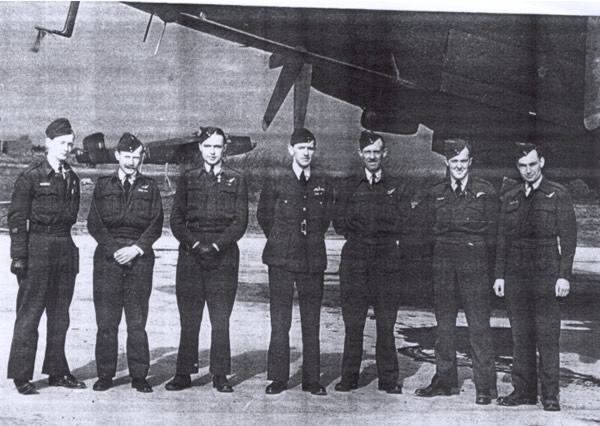
On March 31st 1945 John would marry Leading Aircraftwoman Jean Brownhill whom he met at RAF Riccall while he was carrying out his Halifax conversion. Interestingly he wore his Warrant Officers uniform not his Pilot Officers one. Together they would have two daughters born in 1946 and 1948.
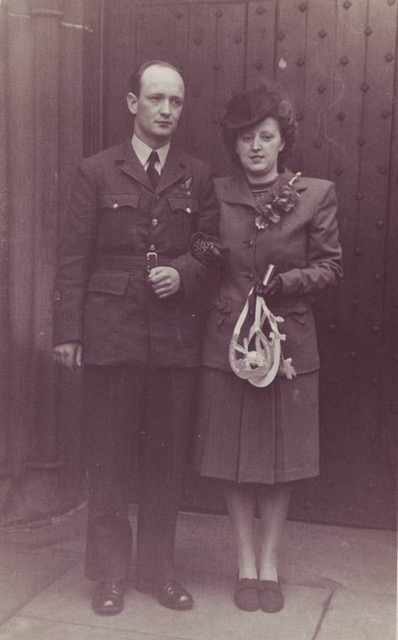
John made his last operational flight for RAF 644 on 21st May 1945 and left for Earls Colne in late June going to 1665 H.C.U. a month later on 27th July. His record now shows him as a flight engineer instructor. In June 1946 he was posted to 1332 H.T.C.U. and onto 1333 T.S.T.U. in December that year having been promoted to Flying Officer in August. John by now had his first child and did not want to keep moving around, he wanted to be with his young family and quite possibly he was beginning the symptoms that would end his life. In March 1947 John was posted to 101 P.D.C for class A release and officially discharged the RAF on Tuesday 17th June 1947 after serving for nearly 10 years.
John would move his family to Cardiff where he would die of Carcinoma of maxillary antrum on Saturday 1st January 1949 aged 27 years, 3 months, 11 days. The RAF were later taken to court by the family and it was deemed that the crash on the morning of 28th September 1943 in Libya while serving with RAAF 462 Squadron had contributed to his illness and subsequent death. A war pension was granted to his widow, who sadly herself would succumb to cancer 21 years later.
John had been a career RAF man and served aboard the Halifax bomber throughout World Two. He is remembered with great pride within the family and as a kind and generous man.
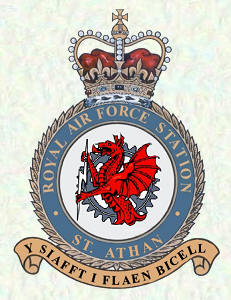
What an amazing story and I’m so grateful to his nephew for reaching out to me from my post in the Halifax Group and supplying the FEAEA with the details and photos of his service life.
Rob Thomas has done a terrific job shedding detail and insight into the wartime service of his uncle and the whole crew he flew with. I know that it has taken him a long time, but it has been worth it – not just for his family but for many of us who are related to crew members.
My wife’s father, Borden Ainley was the Bomb Aimer in the crew and Rob has given us fantastic help piecing together the fractured records of 462. We owe him a great deal, and it is wonderful to see his work published for a wider audience to appreciate.